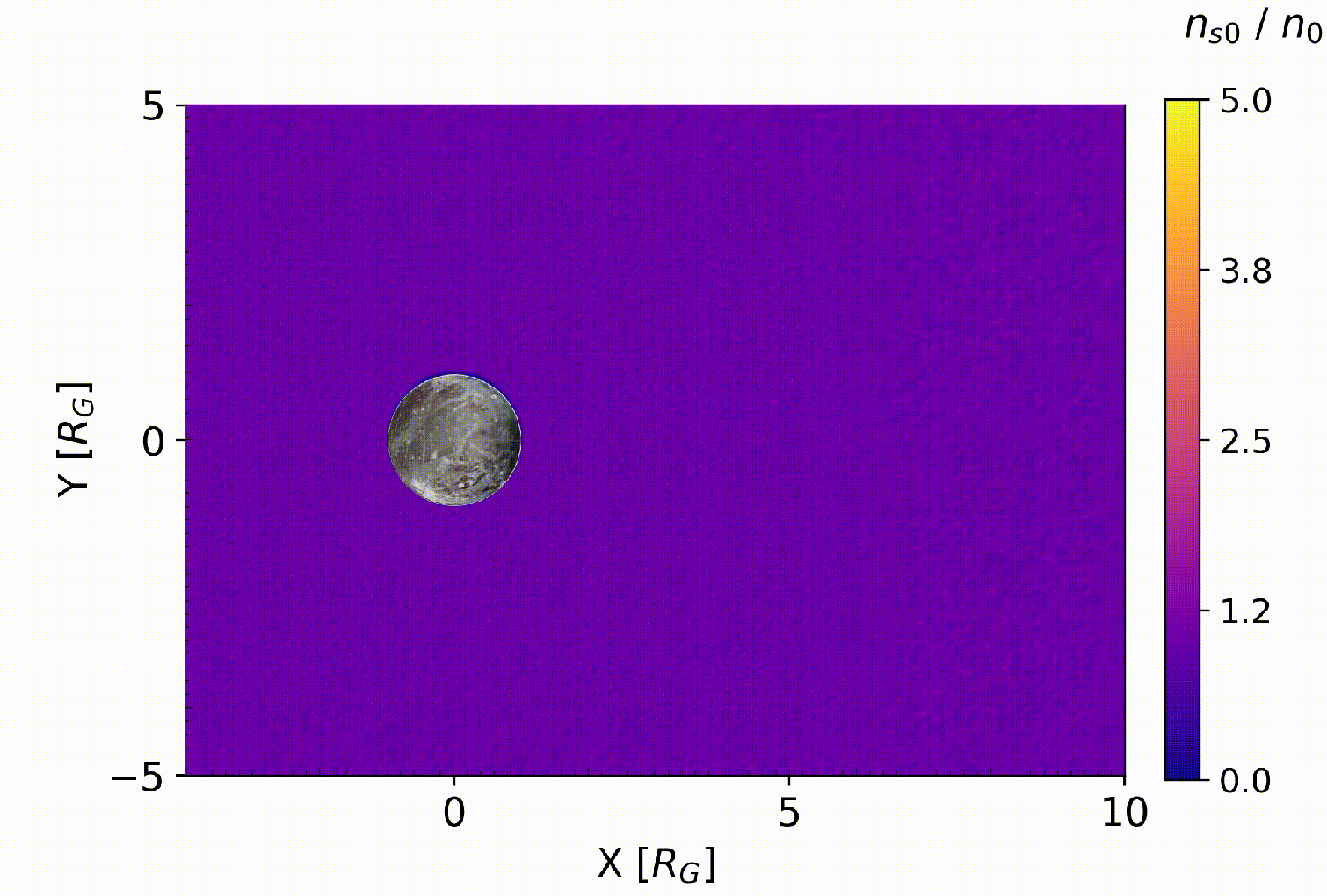Space Plasma Physics
I explore how Jupiter’s moons, Ganymede and Europa, interact with the sea of different plasma species inhabiting the Jovian magnetosphere using computational methods in C++ and Python. Ganymede is the only moon known to possess its own intrinsic magnetic field, forming a “mini-magnetosphere” that protects the moon from impinging Jovian plasma. On the other hand, Europa’s conductive subsurface ocean generates an induced field, which in turn generates a weaker “induced” magnetosphere that perturbs the flow of plasma in the vicinity of the moon. Both satellites possess fascinating dynamical environments that can be described through a combination of fundamental physical principles, advanced numerical techniques, and large datasets generated by spacecraft visiting the environment (e.g., Galileo, Juno).
Below I provide an overview of a sample project of mine in this space, giving character to the nature of cutting-edge space plasma research and the awesome results we can produce with the aid of modern computers.
Ganymede
Project motivations: In June 2021, NASA’s Juno spacecraft performed a close flyby of Ganymede and sampled the moon’s local interaction region. Prior to this event, Ganymede had not been visited since the Galileo mission over 20 years earlier. During its encounter, Juno acquired the first species-resolved observations of ionospheric outflow and sampled the moon’s previously unexplored tail region. These observations represent a significant opportunity to constrain the dynamics and behavior of Ganymede’s ionospheric loss processes, and to study how the kinetic effects of ion gryomotion shape the moon’s plasma tail.
Programming: To understand Ganymede’s plasma interaction during the Juno flyby, I modeled the moon and its environment in C++ starting from the Adaptive Ion Kinetic Electron Fluid source code (AIKEF, see Müller et al., 2011). I programmed a three-dimensional model of Ganymede’s ionosphere and integrated this into the existing AIKEF source code, resulting in the first self-consistent model of Ganymede’s multi-species plasma tail. I also added extensive functionality to AIKEF to accommodate Ganymede’s rich landscape of unique features, including its intrinsically generated global magnetic field and massive conductive subsurface ocean. In addition, I performed extensive statistical analysis on Juno’s magnetometer and plasma observations (e.g., minimum variance analysis) to look for signatures of magnetic reconnection at Ganymede’s magnetopause and to map the structure of the moon’s global magnetic topology.
Results: My research results on this topic are largely summarized in the journal article, A Model of Ganymede’s Magnetic and Plasma Environment During the Juno PJ34 Flyby. Below, I highlight some of the interesting findings.
Our results include the first model demonstration of Kelvin-Helmholtz instability (KHI) forming along Ganymede’s Jupiter-facing magnetopause flank. Asymmetric KHI along the moon’s magnetopause was proposed in a recent study using an analytical 2-D framework (see Kaweeyanun et al., 2021), and is confirmed by our model results. Moreover, the formation of linear Kelvin-Helmholtz waves can be seen propagating toward downstream in the movie of the Jovian plasma density featured below, which displays the emergence of this instability phenomena and its resulting turbulence along the boundary layer.
 Normalized Jovian plasma density \(\left(\frac{n_\mathrm{s0}}{n_0}\right)\) in the equatorial (\(z=0\)) plane, showing the asymmetric development of Kelvin-Helmholtz instability along the Jupiter-facing (\(y>0\)) flank. The \(y\) axis points toward Jupiter and the \(x\) axis points in the direction of the Jovian plasma flow, with both axes given in units of Ganymede radii (\(R_\mathrm{G}=2,634.1\) km).
Normalized Jovian plasma density \(\left(\frac{n_\mathrm{s0}}{n_0}\right)\) in the equatorial (\(z=0\)) plane, showing the asymmetric development of Kelvin-Helmholtz instability along the Jupiter-facing (\(y>0\)) flank. The \(y\) axis points toward Jupiter and the \(x\) axis points in the direction of the Jovian plasma flow, with both axes given in units of Ganymede radii (\(R_\mathrm{G}=2,634.1\) km).
As seen in the figure, the conditions for KHI are not satisfied along the Jupiter-averted (\(y<0)\) magnetopause flank, resulting in a comparably smooth profile in the \(y<0\) half-space of the plasma tail. KHI is an important mechanism for the transport of matter and energy between planetary magnetospheres and the surrounding space, and likely serves a similar function at Ganymede. However, additional research is required to characterize its global significance at this moon.
ENA Imaging
Project motivations: Historically, all space-based measurements of magnetic fields are limited to single lines through 3-D space (i.e., in situ along isolated spacecraft trajectories). As a result, magnetic field data is highly constrained in both time and space, and tells us little about the presence of any global structures in the sampled environment or the physical dynamics underlying the observations. Energetic neutral atom (ENA) images, on the other hand, are 2-D “pictures” of global ENA emissions. Due to the coupling between ENAs and their surrounding electromagnetic environment, these images can also function as 2-D observations of the magnetic field. Hence, in the same way we can photograph a sunset or a waterfall, ENA technology permits “photos” of the magnetic field itself.
The European Space Agency’s JUICE spacecraft, which is scheduled to enter into orbit around Jupiter’s moon, Ganymede, in 2034, is equipped with an ENA camera that will provide thousands of these images near Jupiter, Ganymede, and many of the planet’s other moons. It is therefore critical to understand how ENAs couple to their surrounding electromagnetic environment. This understanding, paired with numerical models relating ENAs and magnetic fields, will provide researchers with the ability to translate raw ENA emissions data into 2-D pictures of the magentic field, potentially reshaping how we engage with magnetospheric physics within the solar system.
